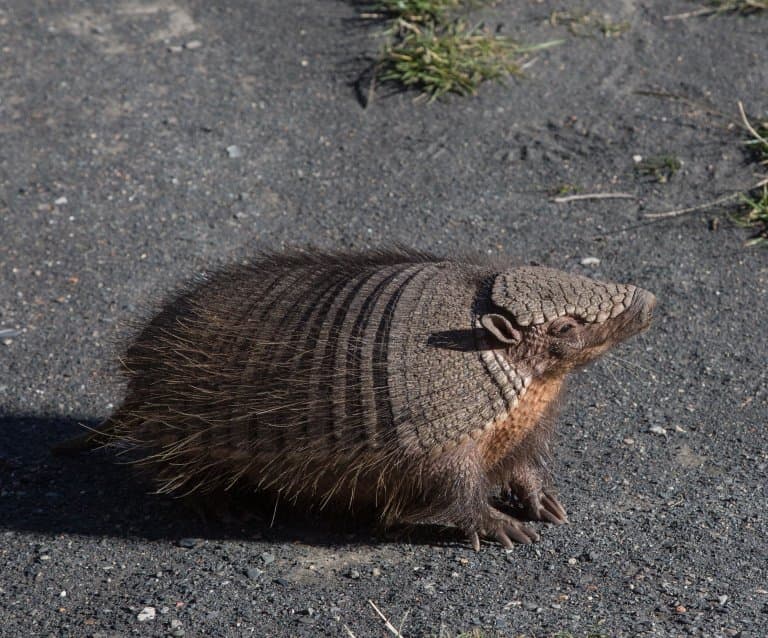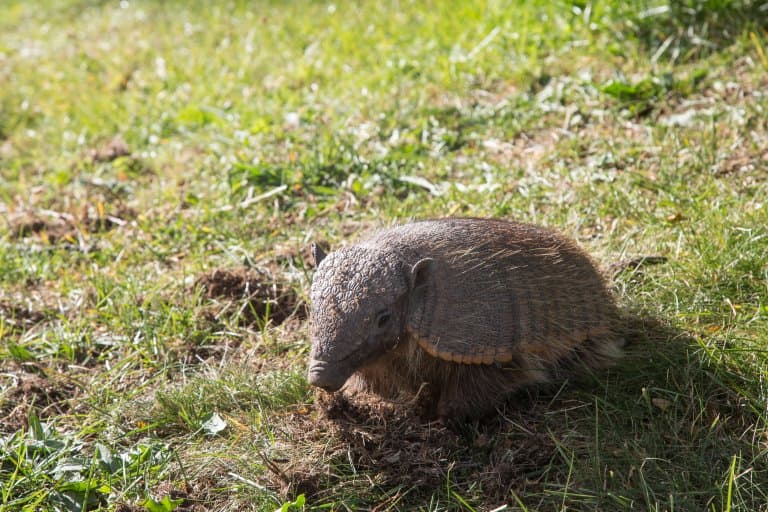Screaming Hairy Armadillo Profile
The screaming hairy armadillo is a small armadillo species found in the South American countries of Paraguay, Bolivia, and Argentina. It lives in a variety of habitat types, wherever the soil is loose enough to dig burrows.
This armadillo is also known as the small screaming armadillo, crying armadillo, or small hairy armadillo because of its unusual, high-pitched weeping scream when threatened.
These screams are thought to deter predators from attacking the armadillo. The screaming hairy armadillo has longer, thicker hair than most other armadillo species.

Screaming Hairy Armadillo Facts Overview
| Habitat: | Most habitat types although absent from rocky areas |
| Location: | South America |
| Lifespan: | Up to 16 years but less in the wild |
| Size: | 30cm in body length. Tail length around 12cm |
| Weight: | Around 800g |
| Color: | Brown with light coloured hair protrudes from between the scutes |
| Diet: | Insects, small vertebrates and some plants |
| Predators: | Jaguars, pumas, large birds of prey and other large carnivorous animals |
| Top Speed: | 45 kph (30 mph) |
| No. of Species: |
1 |
| Conservation Status: |
Least concern |
The screaming hairy armadillo is a solitary animal, that tend to prefer habitats where sand is abundant as it is easier for them to find prey and dig their burrows. Their behaviour and diet is determined by the weather, preferring to hunt for insects in the evening when the weather is hot and then being more active in the day during the cooler months of the year.
They feed mostly on insects and small vertebrates but do also eat plants, especially in the winter when insects are scarce. Interestingly they will occasionally burrow into and under animal carcasses in search of insects.
The screaming hairy armadillo spends much of its time fast asleep! In order to avoid extreme heat and cold, they will burrow deep into the soil where the temperature is more stable. Once awake however, the screaming hairy armadillo will cover large distances away from their main burrow in order to find food. Their eyesight is relatively poor so they locate their food mainly using a heightened sense of smell and a good sense of hearing.
Like most armadillos the screaming hairy armadillo is covered with armour plating. These bony plates grow in the skin and are covered with a thick layer of keratin, the same substance that makes up human fingernails. Large predators are able to break into this protective ‘shell’, however sometimes some are dissuaded from attacking due to the armadillo’s appearance.
The armour also helps armadillos move through thorny scrub as well as increasing heat loss from the body during very hot weather.
Screaming hairy armadillos tend to breed during the slightly cooler months and usually produce one or two litters per year. The litter consists of 2 or occasionally 3 pups that are born without the protective armour of their parents. They are completely blind and helpless at birth, their eyes sometimes only opening after a month.
The pups can weigh as little as 150g at birth. After around 2 months they are weaned and begin finding food for themselves. Once they become fully independent, the young armadillos leave the family unit and take up a solitary existence.
Due to their prolific burrowing activities, screaming hairy armadillos can sometimes become pests in agricultural areas. Their preference for softer soil often means that these armadillos are attracted to farm fields and where they become pests, farmers use hunting dogs to track and kill them. Screaming hairy armadillos are also eaten by people, their meat being a valuable food source and their carapace used to make stringed musical instruments.
They do however play an important role in regulating insect numbers, especially those which themselves are crop pests.
Interesting Screaming Hairy Armadillo Facts
1. Their screams sound a little like pig squeals
When handled or threatened, these armadillos produce a high-pitched squeal similar to pigs. 1
2. They are sometimes called ‘crying’ or ‘weeping’ armadillos
As well as screaming, these armadillos shrieks can also sound like a young person crying.
3. Screaming hairy armadillos are the smallest of the hairy armadillos
The big hairy armadillo and the Andean hairy armadillo are both much larger than this species. 2
4. They have long hair growing in between their scutes
These armadillos are one of the hairiest of all armadillo species.
5. They can not roll themselves into a ball
Only three banded armadillos can roll into a complete ball for protection.
6. 50% of their stomach can be filled with sand
Screaming hairy armadillos can consume large amounts of sand while foraging for food, and large amounts of sand have been recorded in their bellies!

7. The name armadillo means “little armoured one”
Their Spanish name is derived from their plate armour.
8. They are surprisingly rapid
Despite their size and being covered in thick armour, screaming hairy armadillos can move quite quickly. Their strong claws allow them to dig burrows at an impressive pace and when moving above ground they are able to outrun many predators.
Although they are unable to run for very long distances, a screaming hairy armadillo can usually sprint faster than a person can. However when threatened, their first aim is to dive into one of their burrows as quickly as possible.

9. Screaming hairy armadillos are not found in rocky terrain
Armadillos need soft, loose terrain to burrow and are therefore absent from rocky regions.
10. Their home ranges are very large
Screaming hairy armadillos require an area of at least 8 acres to search for their food and make burrows. Considering their size, that’s an awful lot of steps!
11. Screaming hairy armadillos have 18 bands across their backs
Generally 6 to 8 movable bands are found on the carapace of this species, allowing the armadillo to curl up – although not into a ball. 3
12. They have a shield-like plate on their head
As well as on their backs, these armadillos have plates protecting their heads and the back of their necks. As well as digging with their claws, they have also been observed using their pointed heads to dig into the ground.
13. They don’t need to drink regularly
Another adaptation that these little armadillos exhibit is the ability to go for long periods with drinking water. They have very efficient kidneys and can retain water from plants they eat.
Like other desert-dwelling animals, the screaming hairy armadillo can produce very concentrated urine, thereby conserving water and allowing it to occupy rather dry areas.

14. Screaming hairy armadillos have been known to kill snakes
Although they don’t actively hunt snakes, this species has been observed throwing its body against snakes and cutting them with their carapace.
15. They are considered a cultural symbol in Bolivia
For hundreds of years, screaming hairy armadillos have been eaten and their shells used for instrument making in Bolivia.
Screaming Hairy Armadillo Fact-File Summary
Scientific Classification
| Kingdom: | Animalia |
| Phylum: | Chordata |
| Class: | Mammalia |
| Order: | Cingulata |
| Family: | Chlamyphoridae |
| Genus: | Chaetophractus |
| Species Name: |
Chaetophractus Vellerosus |
Fact Sources & References
- Juan P Amaya, Emmanuel Zufiaurre, Juan I Areta, Agustín M Abba (2019), “The weeping vocalization of the screaming hairy armadillo (Chaetophractus vellerosus), a distress call“, Journal of Mammalogy.
- “Screaming hairy armadillo“, Smithsonian’s National Zoo & Conservation Biology Institute.
- “Screaming hairy armadillo“, Atlanta-Fulton County Zoo.
